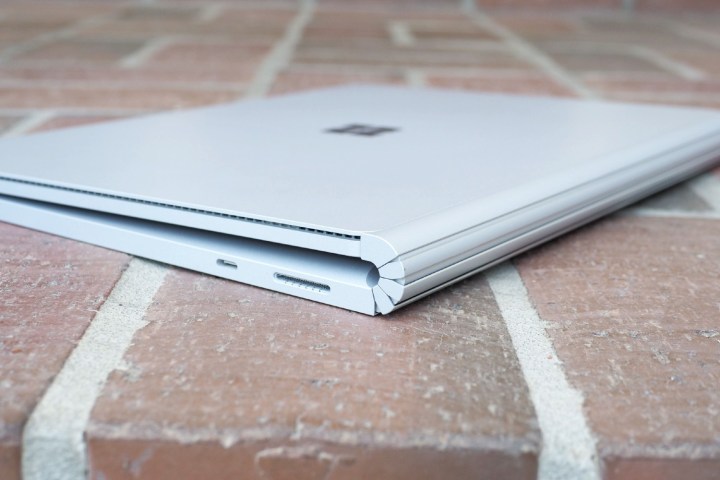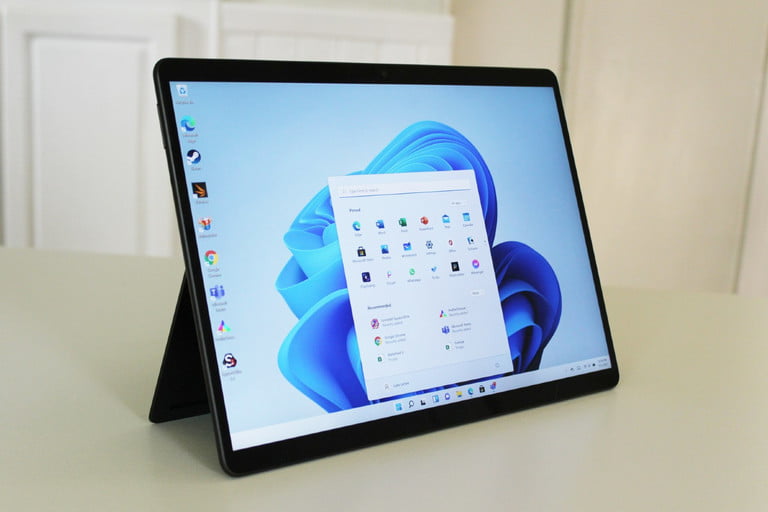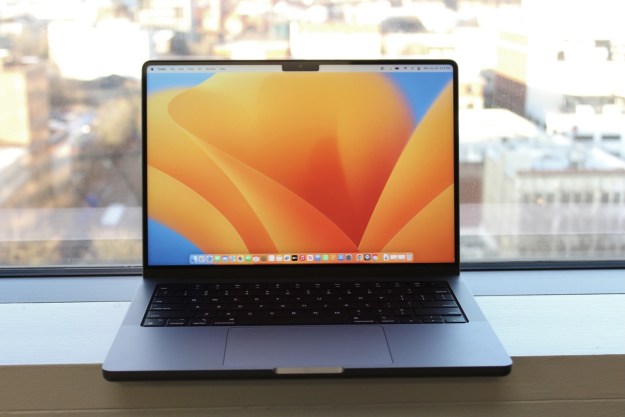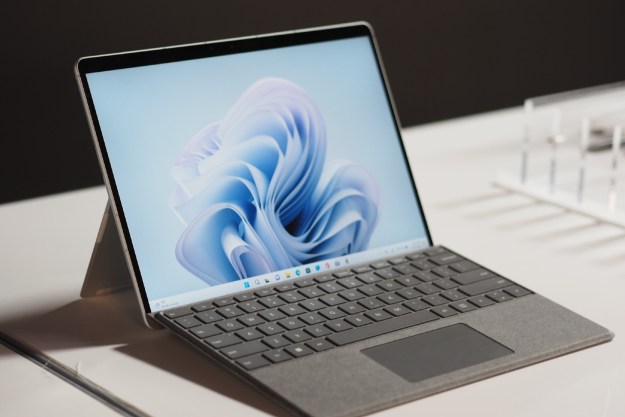When it was introduced, Microsoft’s Surface Book 3 was a genuinely innovative machine, being the third generation of Microsoft’s tear-off display convertible 2-in-1. It’s getting a bit long in the tooth, though, and there’s uncertainty about whether it will be updated. The Surface Pro 8 is the latest in the company’s line of detachable tablets, and it makes some meaningful changes by way of a larger display, smaller display bezels, and (finally!) the inclusion of Thunderbolt 4 support. It’s made our list of best laptops.
Both are great at what they do, but if you’re choosing between them, there are some things to consider. Which is the better machine, the Surface Pro 8 or the Surface Book 3?
Specs
| Microsoft Surface Pro 8 | Microsoft Surface Book 3 13.5-inch | |
| Dimensions | 11.3 inches x 8.2 inches x 0.37 inches | 12.3 inches x 9.14 inches x 0.51 – 0.90 inches |
| Weight | 1.96 pounds (tablet only) | 3.38 pounds |
| Processor | Core i5-1135G7 Core i7-1185G7 |
Intel Core i5-1035G7 Intel Core i7-1065G7 |
| Graphics | Intel Iris Xe | Intel Iris Plus Nvidia GeForce GTX 1650 Max-Q |
| RAM | 8GB 16GB 32GB |
8GB 16GB 32GB |
| Display | 13-inch 3:2 IPS 2,880 x 1,920 | 13.5-inch 3:2 IPS 3,000 x 2,000 |
| Storage | 128GB PCIe SSD 256GB PCIe SSD 512GB PCIe SSD 1TB PCIe SSD |
256GB PCIe SSD 512GB PCIe SSD 1TB PCIe SSD |
| Touch | Yes | Yes |
| Ports | 2 x USB-C with Thunderbolt 4 1 x Surface Connect 3.5mm audio jack Surface Type Cover MicroSD Card reader |
2 x USB-A 3.1 Gen 2 1 x USB-C 3.1 Gen 2 2 x Surface Connect 3.5mm audio jack SD Card reader |
| Wireless | Wi-Fi 6 and Bluetooth 5.1 | Wi-Fi 6 and Bluetooth 5.0 |
| Webcam | Full HD | HD |
| Operating system | Windows 11 | Windows 10 (upgradable to Windows 11) |
| Battery | 51.5 watt-hour | 69 watt-hour (Core i5) or 75.3 watt-hour (Core i7) |
| Price | $1,100+ | $1,600+ |
| Rating | 4 out of 5 stars | 3.5 out of 5 stars |
Design

Both machines are 2-in-1s, meaning that they can convert from a laptop to a tablet by detaching something from something else. The Surface Pro 8 is the more traditional of the two, with a detachable keyboard that can snap on and off the main tablet portion. The Surface Book 3, on the other hand, is a unique design where the display detaches from a keyboard base to become a large 13.5-inch tablet (a 15-inch version is also available). In both cases, most or all the computing power is contained in the tablet portion, while the Surface Book 3 has battery capacity and optional discrete graphics located in the keyboard portion.
Microsoft builds high-quality laptops, and the Surface Pro 8 and Surface Book 3 are no exception. The Surface Pro 8 is constructed of anodized aluminum and is solid as a rock, while the Surface Book 3 is made of magnesium alloy and is equally robust. There’s no bending, flexing, or twisting on either machine. The Surface Book 3 is a more complex design, with a fulcrum hinge to accommodate the heavy display portion. That makes the Surface Pro 8 simpler and less prone to long-term issues.
Naturally, the Surface Pro 8 is the smaller device, coming in at 0.37 inches thick and 1.96 pounds for the tablet alone. Adding the optional $180 Signature Type Cover keyboard will add some weight and thickness, but it’s still much thinner and lighter than the Surface Book 3 and, in fact, rivals the iPad Pro. Note that you might want to add a Surface Pro 8 cover to keep it protected. Thanks to the fulcrum hinge mentioned earlier, the Surface Book 3 is 0.51 inches thick for just the tablet and goes up to 0.90 inches thick at the hinge, and it weighs 3.38 pounds in total. The display portion is much lighter, but Microsoft doesn’t publish its weight. Note as well that the Surface Pro 8 has a built-in kickstand that makes the tablet easier to use — the Surface Book 3’s tablet portion has no kickstand and so is a bit more clumsy.
The Surface Pro 8’s Signature Type Cover provides a snappy mechanism with good key size and spacing and can be propped up at an angle thanks to some magnets. Our only complaint is that there’s some bounce to it when typing that can be distracting. The touchpad is big enough to be useful but is smaller than you’ll find on many traditional clamshell laptops, and it’s smooth and precise. The Surface Book 3 has a more conventional keyboard with deep travel and its own snappy mechanism, with better key spacing and a more solid feel when typing. Its touchpad is larger and just as precise. You’ll enjoy typing and swiping on the Surface Book 3 more than with the Surface Pro 8, but the latter still provides a satisfying experience.
A notable difference is in pen support. The Surface Pro 8 supports the newest $130 Surface Slim Pen 2 with haptic feedback for a more realistic writing feel, and the pen snaps into the Signature Type Cover for storage and charging. The Surface Book 3 will support any of Microsoft’s Surface Pens, but it won’t provide haptic feedback. That’s a win for the Surface Pro 8.
Finally, connectivity is another point of departure. The Surface Pro 8 has fewer connections with just two USB-C ports to go with the Surface Connect port, 3.5mm audio jack, and microSD card reader, but those USB-C ports support Thunderbolt 4 for faster transfer speeds and support for external graphics enclosures. The Surface Book 3 has two USB-A 3.1 Gen 2 ports, a USB-C 3.1 Gen 2 port, a Surface Connect port, a 3.5mm audio jack, and a full-size SD card reader. You’ll miss out on Thunderbolt 4 support. Both laptops support Wi-Fi 6 and Bluetooth 5.1.
Performance

The Surface Pro 8 is available with an 11th-gen Intel Core i5 or i7, which is faster on paper than the 10th-gen Core i5 or i7 available with the Surface Book 3. Our benchmarks bear out this difference, with the Surface Pro 8 scoring slightly higher in Geekbench 5 and considerably faster in our Handbrake test that converts a 420MB video file to H.265. In typical productivity tasks, then, the Surface Pro 8 will be the faster machine.
However, the Surface Book 3 can be configured with an Nvidia GeForce GTX 1650 Max-Q discrete GPU, which is much faster than the Intel Iris Xe graphics in the Surface Pro 8. That makes the Surface Book 3 potentially quicker for gaming and any application that can utilize the GPU, like Adobe’s creative suite.
Both laptops are plenty quick for even demanding productivity workflows, but the Surface Book 3 has the discrete graphics advantage. If you’re looking for a creative workstation, then the Surface Book 3 is the way to go. Of course, the Surface Pro 8 has a Thunderbolt 4 port and can work with an external GPU enclosure. Add an Nvidia RTX GPU through this setup, and suddenly the Surface Pro 8 has the potential to dominate.
Display

Surface devices have always had very good displays, and these two are no different. The Surface Pro 8 has a 13-inch IPS display in the productivity-friendly 3:2 aspect ratio, at a resolution of 2880 x 1920. It has slightly above-average colors at 79% of AdobeRGB and 99% of sRGB, with excellent color accuracy of DeltaE 1.4 (less than 1.0 is excellent). Brightness comes in at 409 nits and contrast at 1,010:1, just above our preferred 1,000:1 threshold. The Surface Book 3 has a 13.5-inch 3:2 IPS display at 3000 x 2000, and it has average colors at 70% of AdobeRGB and 94% of sRGB with color accuracy of 1.58. Brightness is less at 362 nits, but contrast is higher at 1,230:1.
Both displays are great for productivity workers but not quite colorful enough for demanding creative types. However, what sets the Surface Pro 8’s display apart is its 120Hz refresh rate, compared to the Surface Book 3 at 60Hz. That means the Surface Pro 8 will display smoother animations and other on-screen movements, making for a more pleasant experience overall. As mentioned above, the display also supports the Surface Slim Pen 2’s haptic feedback, another plus.
Portability

Without a doubt, the Surface Pro 8 is the more portable device. It’s thinner and lighter even with its keyboard attached, and it’s smaller in all dimensions. The Surface Book 3 is a much thicker and heavier machine that you’ll feel in your backpack.
Battery life makes for an interesting comparison. The Surface Book 3 has up to 75.3 watt-hours of battery capacity spread between the display and the keyboard base, and so when connected, it’s longer-lasting than the Surface Pro 8 with its 51.5 watt-hour battery. However, the difference isn’t as striking as one might expect. In our web browsing test that runs through a series of popular and complex websites, the Surface Pro 8 lasted 8.5 hours compared to the Surface Book 3, with the keyboard base attached at 8.6 hours and just 2.6 hours for the display tablet portion by itself. The Surface Pro 8 lasted for 11 hours in our video test that loops a local Full HD Avengers trailer, compared to the assembled Surface Book 3 at 13.7 hours and 4.9 hours for just the tablet portion.
Those are somewhat surprising results, making the Surface Pro 8 better than expected and mitigating some of the Surface Book 3’s advantages over previous Surface Pro generations. For productivity work, you’ll get similar battery life out of both, at close to a day’s worth, as long as you’re using the Surface Book 3 with its keyboard base attached. Comparing tablet to tablet, though, the Surface Pro 8 is far longer-lasting.
The Surface Pro 8 wins as a tablet, while the Surface Book 3 is the better laptop
The Surface Pro 8 starts at $1,100 for a Core i5, 8GB of RAM, and a 128GB SSD, and maxes out at $2,599 for a Core i7, 32GB of RAM, and a 1TB SSD. It’s affordable at the low end but gets expensive fast.
The Surface Book 3 starts at $1,600 for a Core i5, 8GB of RAM, a 256GB SSD, and integrated graphics. Fully configured, it’s $2,700 for a Core i7, 32GB of
If you’re looking for a tablet first and a laptop second, the Surface Pro 8 is the better choice. It’s also newer and sports more up-to-date components, including a newer CPU and Thunderbolt 4. The latter means that you can expand the Surface Pro 8 into a faster machine than the Surface Book 3. On the other hand, if you want a laptop first and a tablet second, the Surface Book 3 has its advantages. It’s much more comfortable in clamshell mode, while its tablet portion isn’t as convenient or long-lasting.
Editors' Recommendations
- Dell XPS vs. Dell Latitude: here’s how to decide
- MacBook Pro 16 vs. MacBook Pro 14: The important differences
- Best Buy just knocked $440 off this Surface Pro 9 with keyboard
- The case for buying the M2 MacBook Air over the M3 model
- Best Surface Laptop and Surface Pro deals: From $450


